Assessing the Effects of District-Level Segregation on Meritocratic Beliefs in Germany
Abstract
1. Introduction
2. Literature Review
2.1. Perceiving Inequality: The Role of Locality
2.2. Beliefs and Local Inequality: Three Competing Theories
- Newman et al. (2015) put forward and test the “activated class conflict hypothesis”. Based on the assumption that social classes hold latent attitudes relating to their relative position within social hierarchies, they argue that when inequality rises, citizens become aware of this relative position and adjust their beliefs accordingly. Newman et al. (2015) find that when inequality is high, low-income individuals are more likely to reject meritocratic beliefs, in contrast to higher incomes groups who are more likely to embrace these beliefs.
- Solt et al. (2016) do not only offer a methodological critique of Newman et al. (2015), but focus on the dimension of discourse. As social discourses are shaped through power relations, they propose that high inequality increases the ability of those in power to influence public discourse in a way that justifies the current system. In contrast to the findings of Newman et al. (2015), they find that low-income individuals are more likely to hold meritocratic beliefs when inequality is high. Their findings were recently, in part, corroborated by Morris et al. (2022).
- Mijs (2018) offers a somewhat different theoretical approach. He proposes that individuals who encounter people from a diverse range of social backgrounds and social positions will become more critical of meritocratic principles than those whose social relations are more homogeneous. The more diverse the relationships of individuals are, the more likely they are to experience (by proxy) different facets of success and failure, leading them to call meritocratic principles into question (Mijs 2018, 2019). He argues that as inequality rises, so does segregation between social groups, making citizens less likely to meet those from different social backgrounds. More recent work supports these findings (García-Castro et al. 2020).
2.3. A Note on the Underlying Mechanisms
2.4. Segregation and Meritocratic Beliefs in Germany
3. Data and Method
3.1. Data
3.2. Dependent Variable
3.3. Independent Variables
3.3.1. District-Level Segregation
3.3.2. District-Level Controls
3.3.3. Individual-Level Controls
3.4. Method and Models
4. Results
4.1. District-Level Segregation and Meritocratic Beliefs: An Urban Phenomenon?
4.2. Probing the Results: MAUP and Spatial Units
5. Discussion
6. Conclusions
Author Contributions
Funding
Institutional Review Board Statement
Informed Consent Statement
Data Availability Statement
Conflicts of Interest
Appendix A
| Variable | Coding | Description |
|---|---|---|
| Meritocratic beliefs | 0–100 | “One has to work hard in order to succeed”, agree at all) to 7 (completely agree), rescaled [SOEP data] |
| Dissimilarity index | 0–1 | microm status data, calculated following Duncan and Duncan (1955) [SOEP data] |
| Isolation index | 0–1 | microm status data, calculated following Bell (1954) for both high and low status [SOEP data] |
| Avg. monthly income per inhabitant (EUR) | district-level household income [INKAR data] | |
| Population density | district-level total population divided by 10,000 [INKAR data] | |
| Foreign population | individuals without German citizenship of total population in % [INKAR data] | |
| Proportion of basic benefits recipients (SGBII) | 0 = below1 = above | individuals without German citizenship of total population in %, dummy coded on 3rd quartile [INKAR data] |
| Proportion of high-income households | 0 = below1 = above | Proportion of household with net income above EUR 3600 per month of total population in %, dummy coded on 3rd quartile [INKAR data] |
| Equivalized monthly household income (EUR 000) | OECD equivalized monthly income divided by 1000 [SOEP data] | |
| Duration of residence (years) | own calculation [SOEP data] | |
| Region | 0 = West1 = East | NUTS region (East–West Version), recoded [SOEP data] |
| District type | 0 = urban1 = rural | spatial category by BBSR [SOEP data] |
| Moved in the past year | 0 = no1 = yes | own calculation [SOEP data] |
| Gender | 0 = female1 = male | female = 1, male = 2, recoded [SOEP data] |
| Migration background | 0 = none1 = first gen2 = second gen | migration background, no migration background = 1, first generation = 2, second generation = 3, recoded [SOEP data] |
| Age group | 0 = under 651 = aged 65+ | Calculated based on year of birth, dummy coded [SOEP data] |
| University educated | 0 = degree1 = no degree | CASMIN, recoded, 3a/3b Tertiary Education = 0 [SOEP data] |
| Unemployed | 0 = no1 = yes | Labor force status, recoded, 1 = registered unemployed [SOEP data] |
| Religion | 0 = no1 = yes | Religion, non-denominational = 0 [SOEP data] |
| Political attitude | 0 = other1 = left-leaning2 = right-leaning | “If you think about your own political views: Where would you place yours?”, 0 (left) to 10 (right), recoded to left (0–4), right (6–10), other (5) [SOEP data, 2014] |

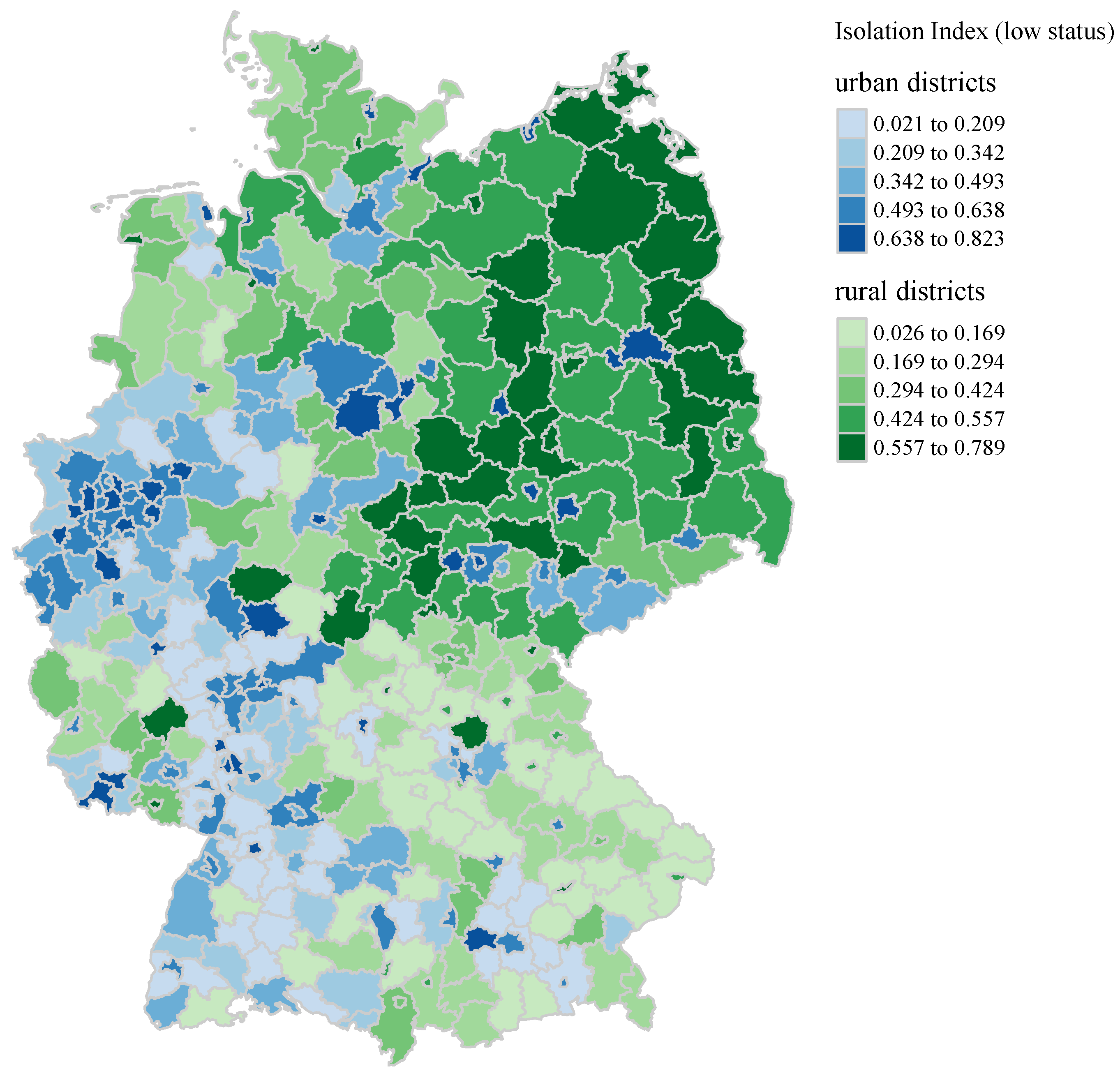
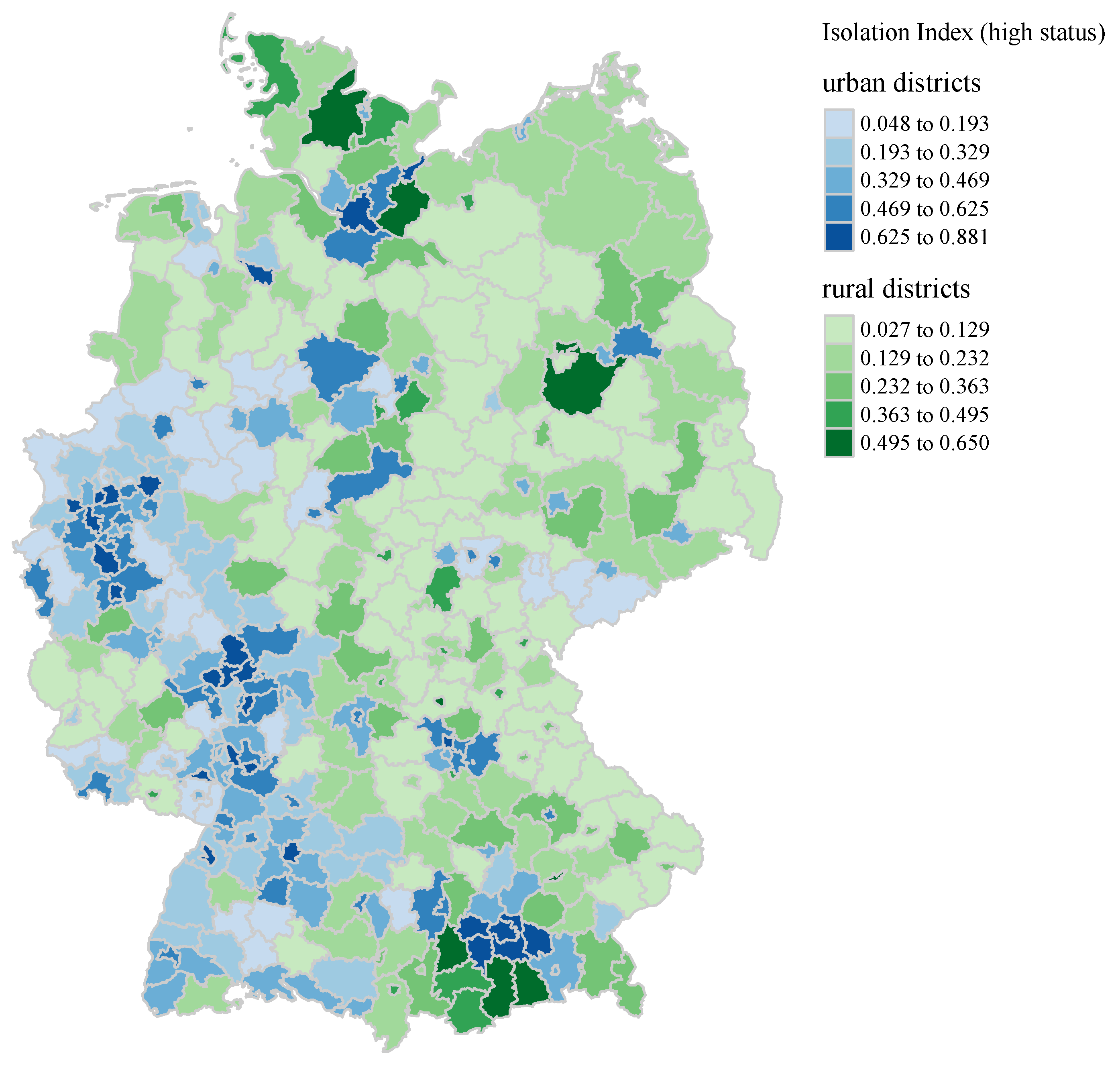
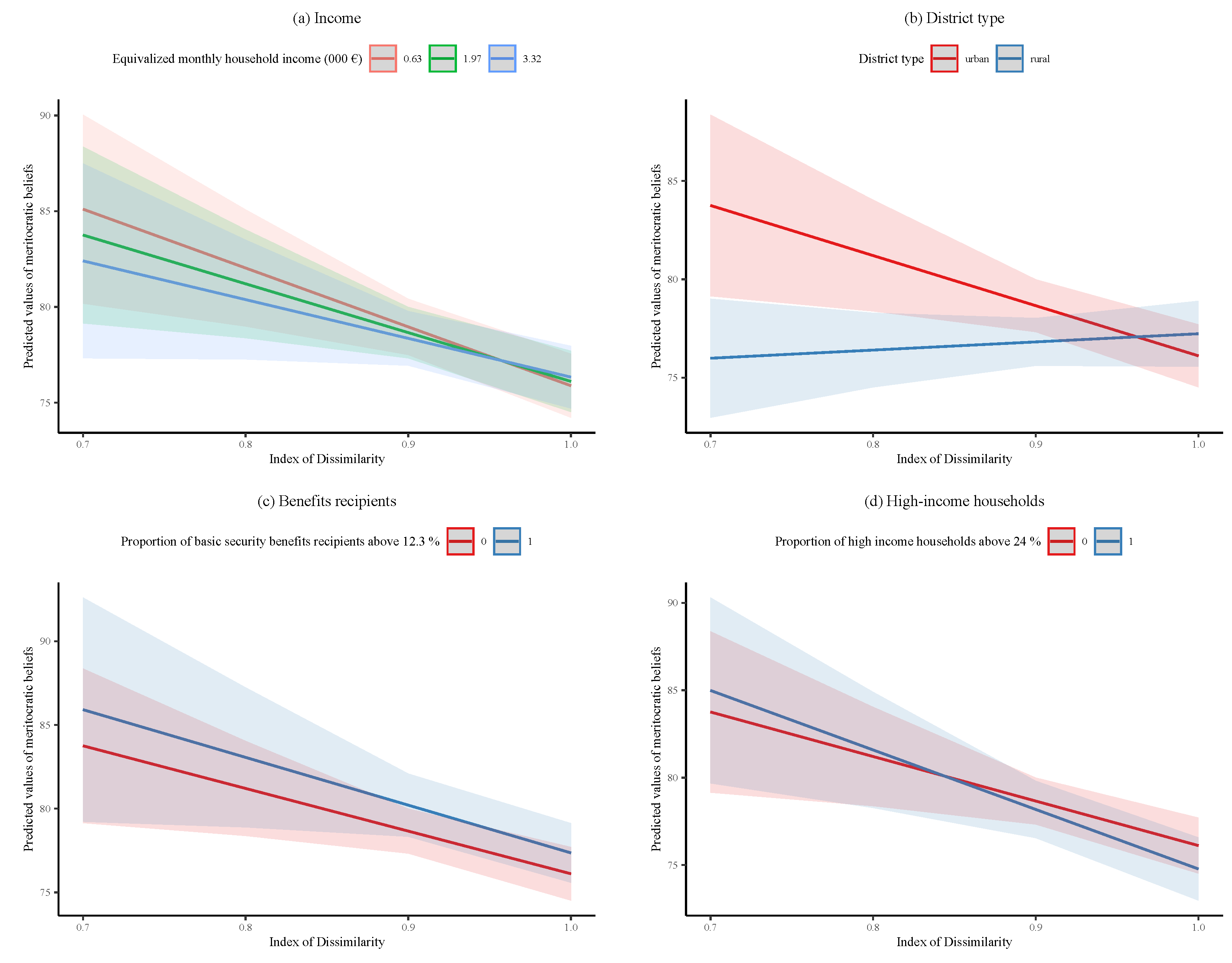
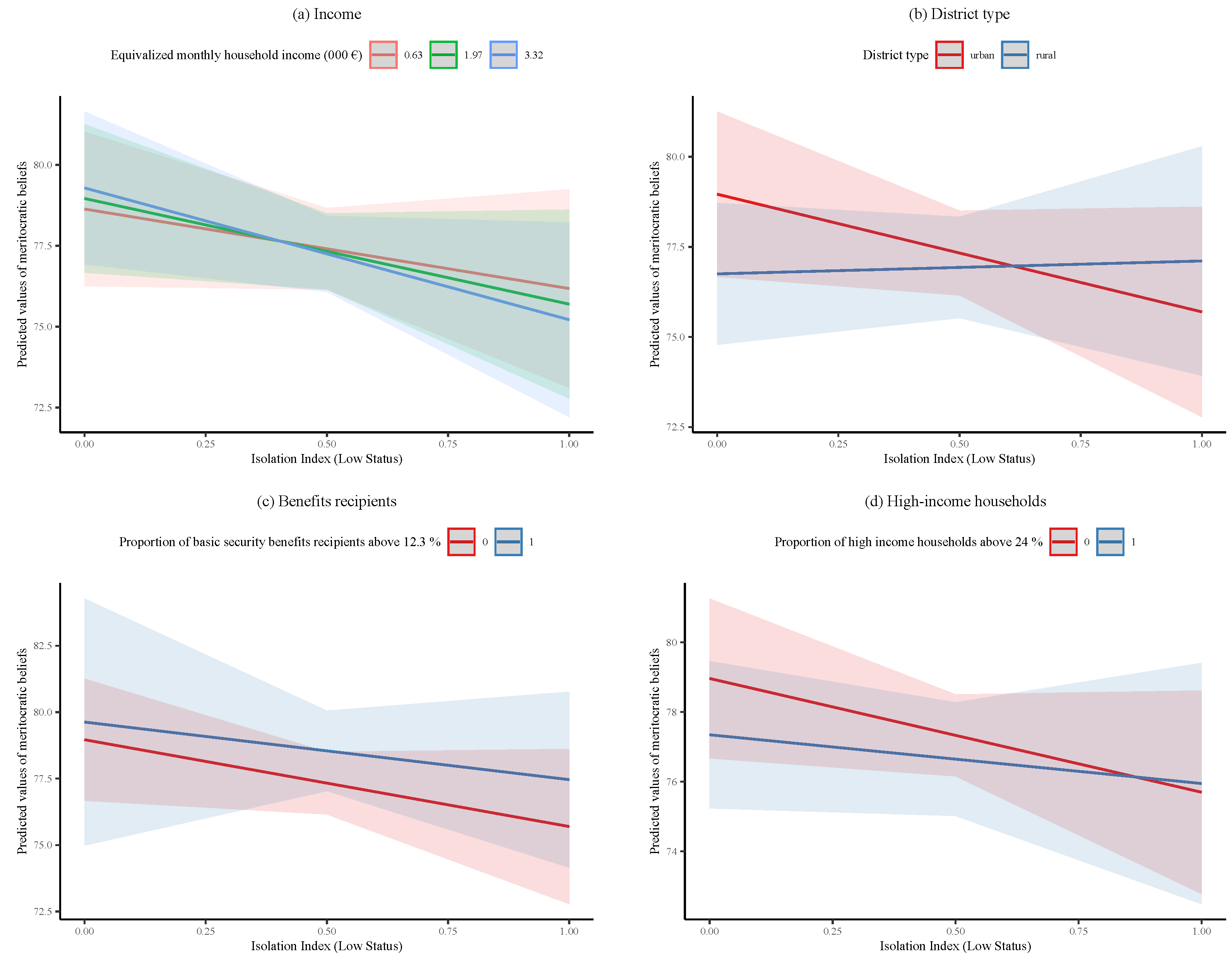

| “Dissimilarity Index” | “Isolation Index (Low Status)” | “Isolation Index (High Status)” | ||||
|---|---|---|---|---|---|---|
| (XI) | (XII) | (XIII) | (XIV) | (XV) | (XVI) | |
| District level | ||||||
| (Intercept) | 78.60 (0.95) *** | *** | *** | *** | *** | *** |
| Index | * | ** | ||||
| Avg. monthly income (EUR 000) | ||||||
| Population density | ||||||
| Foreign population | ||||||
| Basic security benefits (> 12.3%) | * | ** | * | |||
| High-income households (> 24%) | ||||||
| Region: East | ** | ** | ** | ** | ** | |
| Rural Areas | * | * | ||||
| Individual level | ||||||
| Household income (EUR 000) | ||||||
| Moved in the past year | ||||||
| Duration of residence (years) | ||||||
| Male | *** | *** | *** | *** | *** | *** |
| First-generation migrant | *** | *** | *** | *** | *** | *** |
| Second-generation migrant | *** | *** | *** | *** | *** | *** |
| Aged 65+ | *** | *** | *** | *** | *** | *** |
| No university degree | *** | *** | *** | *** | *** | *** |
| Unemployed | ||||||
| Religious | ||||||
| Left-leaning | *** | *** | *** | *** | *** | *** |
| Right-leaning | * | * | * | * | * | * |
| Interaction terms | ||||||
| Index × income | ||||||
| Index × rural area | ||||||
| Index × benefits | ||||||
| Index × high income | ||||||
| Num. obs. | 21,263 | 21,263 | 21,059 | 21,059 | 21,059 | 21,059 |
| Num. groups: hid:kkz_rek | 13,325 | 13,325 | 13,192 | 13,192 | 13,192 | 13,192 |
| Num. groups: kkz_rek | 388 | 388 | 387 | 387 | 387 | 387 |
| Var: hid:kkz_rek (Intercept) | ||||||
| Var: kkz_rek (Intercept) | ||||||
| Var: Residual | ||||||
| 1 | District boundaries based on the jurisdictional boundaries present on 31 December 2017, provided by the time-series data by INKAR. |
| 2 | The Research Data Center of the Federal Statistical Office is currently examining the possibility of further re-use of the data. |
| 3 | While there certainly is a case to be made for the inclusion of additional facets playing into how individuals think about inequality—as is demonstrated by Mijs (2019), who includes a measure of structural beliefs—we opt to focus thoroughly on work-based meritocratic beliefs.As beliefs about work-based and structural factors of inequality are complementary (Mijs 2018), we believe the choice is justified. |
| 4 | While there is some debate regarding treating scale items as continuous (Schröder and Yitzhaki 2017), it is considered to be feasible when there are more than five categories, as is the case here (Frijters et al. 2004). |
| 5 |
References
- Adriaans, Jule, Sandra Bohmann, Matteo Targa, Stefan Liebig, Thomas Hinz, Guillermina Jasso, Bernhard Kittel, and Clara Sabbagh. 2020. Justice and Fairness in Europe: Topline Results from Round 9 of the European Social Survey. Technical Report 10. London: European Social Survey. [Google Scholar]
- Ahrens, Leo. 2019. Theorizing the Impact of Fairness Perceptions on the Demand for Redistribution. Political Research Exchange 1: 1–17. [Google Scholar] [CrossRef]
- Almås, Ingvild, Alexander W. Cappelen, Erik Sørensen, and Bertil Tungodden. 2022. Attitudes to Inequality: Preferences and Beliefs. In IFS Deaton Review of Inequalities. London: The Institute for Fiscal Studies. [Google Scholar]
- Baba, Ludger, and Katrin Wilbert. 2022. Soziale Stadt- und Ortsentwicklung in ländlichen Räumen. Bonn: BBSR Online-Publikation, Bundesinstitut für Bau-, Stadt- und Raumforsschung. [Google Scholar]
- Bailey, Nick, Maria Gannon, Ade Kearns, Mark Livingston, and Alastair H. Leyland. 2013. Living Apart, Losing Sympathy? How Neighbourhood Context Affects Attitudes to Redistribution and to Welfare Recipients. Environment and Planning A: Economy and Space 45: 2154–75. [Google Scholar] [CrossRef]
- Barth, Denise, Jonas Jessen, Christa Katharina Spieß, and Katharina Wrohlich. 2020. Mütter in Ost und West: Angleichung bei Erwerbstätigenquoten und Einstellungen, nicht bei Vollzeiterwerbstätigkeit. DIW Wochenbericht 87: 699–706. [Google Scholar] [CrossRef]
- Bates, Douglas, Martin Mächler, Ben Bolker, and Steve Walker. 2015. Fitting Linear Mixed-Effects Models Using lme4. Journal of Statistical Software 67: 1–48. [Google Scholar] [CrossRef]
- BBSR. 2023. INKAR—Indikatoren und Karten zur Raum- und Stadtentwicklung. Available online: www.inkar.de (accessed on 23 March 2023).
- Becker, Rolf, and Andreas Hadjar. 2011. Meritokratie: Zur gesellschaftlichen Legitimation ungleicher Bildungs-, Erwerbs- und Einkommenschancen in modernen Gesellschaften. In Lehrbuch der Bildungssoziologie. Edited by Rolf Becker. Wiesbaden: VS Verlag für Sozialwissenschaften, pp. 37–62. [Google Scholar] [CrossRef]
- Bell, W. 1954. A Probability Model for the Measurement of Ecological Segregation. Social Forces 32: 357–64. [Google Scholar] [CrossRef]
- Bernardo, Allan B. I. 2021. Meritocracy Beliefs and Intolerance Towards Wealth Inequality among Higher Subjective Social Status Filipinos. International Journal of Social Psychology 36: 397–423. [Google Scholar] [CrossRef]
- Bjørnskov, Christian, Axel Dreher, Justina A.V. Fischer, Jan Schnellenbach, and Kai Gehring. 2013. Inequality and happiness: When perceived social mobility and economic reality do not match. Journal of Economic Behavior & Organization 91: 75–92. [Google Scholar] [CrossRef]
- Bottero, Wendy. 2020. A Sense of Inequality. Transforming Capitalism. London: Rowman & Littlefield International. [Google Scholar]
- Brunori, Paolo, Francisco H. G. Ferreira, and Vito Peragine. 2013. Inequality of Opportunity, Income Inequality, and Economic Mobility: Some International Comparisons. In Getting Development Right Structural Transformation, Inclusion, and Sustainability in the Post-Crisis Era. Edited by Eva Paus. New York: Palgrave Macmillan. [Google Scholar]
- Bublitz, Elisabeth. 2022. Misperceptions of Income Distributions: Cross-Country Evidence from a Randomized Survey Experiment. Socio-Economic Review 20: 435–62. [Google Scholar] [CrossRef]
- Butterwege, Christoph. 2015. Hartz IV und die Folgen. Gesundheits- und Sozialpolitik 69: 38–53. [Google Scholar] [CrossRef]
- Cunningham, Niall, and Mike Savage. 2015. The Secret Garden? Elite Metropolitan Geographies in the Contemporary UK. The Sociological Review 63: 321–48. [Google Scholar] [CrossRef]
- Dauth, Wolfgang, and Peter Haller. 2018. Berufliches Pendeln zwischen Wohn- und Arbeitsort: Klarer Trend zu längeren Pendeldistanzen. IAB Kurzbericht No. 10/2018. Nürnberg: Institut für Arbeitsmarkt- und Berufsforschung. [Google Scholar]
- Dittmann, Jörg, and Jan Goebel. 2010. Your House, Your Car, Your Education: The Socioeconomic Situation of the Neighborhood and its Impact on Life Satisfaction in Germany. Social Indicators Research 96: 497–513. [Google Scholar] [CrossRef]
- Duclos, Jean-Yves, Joan Esteban, and Debraj Ray. 2004. Polarization: Concepts, Measurement, Estimation. Econometrica 72: 1737–72. [Google Scholar] [CrossRef]
- Duncan, Otis Dudley, and Beverly Duncan. 1955. A Methodological Analysis of Segregation Indexes. American Sociological Review 20: 210–17. [Google Scholar] [CrossRef]
- Elff, Martin, and Sigrid Roßteutscher. 2016. Parteiwahl und Nichtwahl: Zur Rolle sozialer Konfliktlinien. In Wahlen und Wähler. Edited by Harald Schoen and Bernhard Weßels. Wiesbaden: Springer Fachmedien Wiesbaden, pp. 45–69. [Google Scholar]
- Enos, Ryan D. 2017. The Space between Us: Social Geography and Politics. Cambridge: Cambridge University Press. [Google Scholar]
- Eurofound. 2021. Wealth Distribution and Social Mobility. Technical Report. Luxembourg: Publications Office of the European Union. [Google Scholar]
- Eurostat. 2023. Living Conditions in Europe—Income Distribution and Income Inequality. Available online: https://ec.europa.eu/eurostat/statistics-explained/index.php?title=Living_conditions_in_Europe_-_income_distribution_and_income_inequality (accessed on 22 March 2023).
- Fastenrath, Florian, Paul Marx, Achim Truger, and Helena Vitt. 2022. Why Is It So Difficult to Tax the Rich? Evidence from German Policy-Makers. Journal of European Public Policy 29: 767–86. [Google Scholar] [CrossRef]
- Franko, William W., and Avery C. Livingston. 2020. Economic Segregation and Public Support for Redistribution. The Social Science Journal 59: 1–19. [Google Scholar] [CrossRef]
- Frijters, Paul, John P. Haisken-Denew, and Michael A. Shields. 2004. Money Does Matter! Evidence from Increasing Real Income and Life Satisfaction in East Germany Following Reunification. American Economic Review 94: 730–40. [Google Scholar] [CrossRef]
- Galster, George, and Patrick Sharkey. 2017. Spatial Foundations of Inequality: A Conceptual Model and Empirical Overview. RSF: The Russell Sage Foundation Journal of the Social Sciences 3: 1–33. [Google Scholar] [CrossRef]
- García-Castro, Juan Diego, Rosa Rodríguez-Bailón, and Guillermo B. Willis. 2020. Perceiving Economic Inequality in Everyday Life Decreases Tolerance to Inequality. Journal of Experimental Social Psychology 90: 104019. [Google Scholar] [CrossRef]
- García-Sánchez, Efraín, Danny Osborne, Guillermo B. Willis, and Rosa Rodríguez-Bailón. 2020. Attitudes Towards Redistribution and the Interplay between Perceptions and Beliefs about Inequality. British Journal of Social Psychology 59: 111–36. [Google Scholar] [CrossRef]
- Goebel, Jan, Markus M. Grabka, Stefan Liebig, Martin Kroh, David Richter, Carsten Schröder, and Jürgen Schupp. 2019. The German Socio-Economic Panel (SOEP). Jahrbücher für Nationalökonomie und Statistik 239: 345–60. [Google Scholar] [CrossRef]
- Goebel, Jan, Martin Gornig, and Hartmut Häußermann. 2010. Polarisierung der Einkommen: Die Mittelschicht verliert. DIW Wochenbericht 77: 2–8. [Google Scholar]
- Goebel, Jan, and Lukas Hoppe. 2015. Ausmaß und Trends sozialräumlicher Segregation in Deutschland: Abschlussbericht. Technical Report. Berlin: Bundesministerium für Arbeit und Soziales. [Google Scholar]
- Grabka, Markus M., and Carsten Schröder. 2019. The Low-Wage Sector in Germany Is Larger Than Previously Assumed. DIW Weekly Report 9: 117–24. [Google Scholar] [CrossRef]
- Grabka, Markus M., and Christian Westermeier. 2015. Persistently High Wealth Inequality in Germany. DIW Economic Bulletin 13: 459–86. [Google Scholar] [CrossRef]
- Groh-Samberg, Olaf, Theresa Büchler, and Jean-Yves Gerlitz. 2020. Soziale Lagen in Multidimensionaler Längsschnittbetrachtung. Technical Report. Berlin: Bundesministerium für Arbeit und Soziales. [Google Scholar]
- Gunlicks, Arthur B. 2003. Administrative Structures in Germany. In The Länder and German Federalism. Manchester: Manchester University Press, pp. 81–140. [Google Scholar]
- Helbig, Marcel, and Stefanie Jähnen. 2018. Wie brüchig ist die soziale Architektur unserer Städte? Trends und Analysen der Segregation in 74 deutschen Städten. Technical Report. Berlin: Wissenschaftszentrum Berlin für Sozialforschung. [Google Scholar]
- Heuer, Jan-Ocko, Thomas Lux, Steffen Mau, and Katharina Zimmermann. 2020. Legitimizing Inequality: The Moral Repertoires of Meritocracy in Four Countries. Comparative Sociology 19: 542–84. [Google Scholar] [CrossRef]
- Huijsmans, Twan, Eelco Harteveld, Wouter van der Brug, and Bram Lancee. 2021. Are Cities Ever More Cosmopolitan? Studying Trends in Urban-Rural Divergence of Cultural Attitudes. Political Geography 86: 102353. [Google Scholar] [CrossRef]
- Immel, Lea, and Andreas Peichl. 2020. Regionale Ungleichheit in Deutschland: Wo leben die Reichen und wo die Armen? ifo Schnelldienst 73: 43–47. [Google Scholar]
- Irwin, Sarah. 2018. Lay Perceptions of Inequality and Social Structure. Sociology 52: 211–27. [Google Scholar] [CrossRef]
- Kluegel, James R., and Eliot R. Smith. 1986. Beliefs about Inequality: Americans’ Views of What Is and What Ought to Be. Social Institutions and Social Change. New York: A. de Gruyter. [Google Scholar]
- Knies, Gundi. 2010. Income Comparisons among Neighbours and Life Satisfaction in East and West Germany. Social Indicators Research 106: 471–89. [Google Scholar] [CrossRef]
- Lamont, Michèle, and Paul Pierson. 2019. Inequality Generation & Persistence as Multidimensional Processes: An Interdisciplinary Agenda. Daedalus 148: 5–18. [Google Scholar] [CrossRef]
- Larsen, Christian Albrekt. 2016. How Three Narratives of Modernity Justify Economic Inequality. Acta Sociologica 59: 93–111. [Google Scholar] [CrossRef]
- Leifeld, Philip. 2013. texreg: Conversion of Statistical Model Output in to L A T E X and HTML Tables. Journal of Statistical Software 55: 1–24. [Google Scholar] [CrossRef]
- Lierse, Hanna. 2019. Why is There Not More Demand for Redistribution? Cross-National Evidence for the Role of Social Justice Beliefs. International Journal of Public Opinion Research 31: 121–41. [Google Scholar] [CrossRef]
- Linke, Simone. 2016. Sozialräumliche Segregation in ländlich bezeichneten Räumen. In Fraktale Metropolen. Edited by Florian Weber and Olaf Kühne. Wiesbaden: Springer Fachmedien Wiesbaden, pp. 245–70. [Google Scholar]
- Massey, Douglas S., and Nancy A. Denton. 1988. The Dimensions of Residential Segregation. Social Forces 67: 281. [Google Scholar] [CrossRef]
- McCall, Leslie, Derek Burk, Marie Laperrière, and Jennifer A. Richeson. 2017. Exposure to Rising Inequality Shapes Americans’ Opportunity Beliefs and Policy Support. Proceedings of the National Academy of Sciences of the United States of America 114: 9593–98. [Google Scholar] [CrossRef]
- McCall, Leslie, and Fiona Chin. 2013. Does Knowledge of Inequality Affect Beliefs about Inequality? Proceedings of the Midwest Political Science Association Meeting, Chicago, IL, USA, April 13. [Google Scholar]
- microm. 2019. Das Datenhandbuch 2019. Technical Report. Neuss: Micromarketing-Systeme und Consult GmbH. [Google Scholar]
- Mijs, Jonathan. 2018. Inequality Is a Problem of Inference: How People Solve the Social Puzzle of Unequal Outcomes. Societies 8: 64. [Google Scholar] [CrossRef]
- Mijs, Jonathan. 2019. The Paradox of Inequality: Income Inequality and Belief in Meritocracy Go Hand in Hand. Socio-Economic Review 19: 7–35. [Google Scholar] [CrossRef]
- Mijs, Jonathan J.B., and Mike Savage. 2020. Meritocracy, Elitism and Inequality. The Political Quarterly 91: 397–404. [Google Scholar] [CrossRef]
- Mijs, Jonathan J.B., Stijn Daenekindt, Willem de Koster, and Jeroen van der Waal. 2022. Belief in Meritocracy Reexamined: Scrutinizing the Role of Subjective Social Mobility. Social Psychology Quarterly 85: 131–41. [Google Scholar] [CrossRef]
- Minkoff, Scott L., and Jeffrey Lyons. 2019. Living with Inequality: Neighborhood Income Diversity and Perceptions of the Income Gap. American Politics Research 47: 329–61. [Google Scholar] [CrossRef]
- Mooser, Barbara. 2022. 79 Einkommens-Millionäre im Landkreis Ebersberg. Süddeutsche Zeitung Online. Available online: https://www.sueddeutsche.de/muenchen/ebersberg/millionaere-landkreis-ebersberg-statistik-1.5640206 (accessed on 16 August 2022).
- Morris, Katy, Felix Bühlmann, Nicolas Sommet, and Leen Vandecasteele. 2022. The Paradox of Local Inequality: Meritocratic Beliefs in Unequal Localities. The British Journal of Sociology 73: 421–60. [Google Scholar] [CrossRef]
- Newman, Benjamin J., Christopher D. Johnston, and Patrick L. Lown. 2015. False Consciousness or Class Awareness? Local Income Inequality, Personal Economic Position, and Belief in American Meritocracy. American Journal of Political Science 59: 326–40. [Google Scholar] [CrossRef]
- Niehues, Judith. 2016. Ungleichheit: Wahrnehmung und Wirklichkeit – Ein internationaler Vergleich. Wirtschaftsdienst 96: 13–18. [Google Scholar] [CrossRef]
- Niehues, Judith. 2019. Wunsch und Wirklichkeit—Subjektive Umverteilungspräferenzen in Deutschland. IW Trends 46: 79–98. [Google Scholar] [CrossRef]
- Noll, Heinz-Herbert, and Friedrich Schuster. 1992. Soziale Schichtung: Niedrige Einstufung der Ostdeutschen: Wahrnehmung und Bewertung Sozialer Ungleichheit im Ost-West-Vergleich. Informationsdienst Soziale Indikatoren 7: 1–6. [Google Scholar] [CrossRef]
- Openshaw, Stan. 1983. The Modifiable Areal Unit Problem. Number 38 in Concepts and Techniques in Modern Geography. Norwich: Geo Books. [Google Scholar]
- Openshaw, Stan. 1984. Ecological Fallacies and the Analysis of Areal Census Data. Environment and Planning A: Economy and Space 16: 17–31. [Google Scholar] [CrossRef]
- Reardon, Sean F., and Kendra Bischoff. 2011. Income Inequality and Income Segregation. American Journal of Sociology 116: 1092–1153. [Google Scholar] [CrossRef]
- Sachweh, Patrick, and Evelyn Sthamer. 2019. Why Do the Affluent Find Inequality Increasingly Unjust? Changing Inequality and Justice Perceptions in Germany, 1994–2014. European Sociological Review 35: 651–68. [Google Scholar] [CrossRef]
- Sager, Lutz. 2012. Residential Segregation and Socioeconomic Neighbourhood Sorting: Evidence at the Micro-neighbourhood Level for Migrant Groups in Germany. Urban Studies 49: 2617–32. [Google Scholar] [CrossRef]
- Salomo, Katja. 2019. The Residential Context as Source of Deprivation: Impacts on the Local Political Culture. Evidence from the East German State Thuringia. Political Geography 69: 103–17. [Google Scholar] [CrossRef]
- Sandberger, Johann-Ulrich. 1983. Zwischen Legitimation und Kritik. Vorstellungen von Akademikern, Studenten und Bevölkerung zur sozialen Ungleichheit. Zeitschrift für Soziologie 12: 181–202. [Google Scholar] [CrossRef]
- Sands, Melissa L. 2017. Exposure to inequality affects support for redistribution. Proceedings of the National Academy of Sciences of the United States of America 114: 663–68. [Google Scholar] [CrossRef] [PubMed]
- Sands, Melissa L., and Daniel de Kadt. 2020. Local Exposure to Inequality Raises Support of People of Low Wealth for Taxing the Wealthy. Nature 586: 257–61. [Google Scholar] [CrossRef] [PubMed]
- Savage, Mike, and Elizabeth B. Silva. 2013. Field Analysis in Cultural Sociology. Cultural Sociology 7: 111–26. [Google Scholar] [CrossRef]
- Schielzeth, Holger, Niels J. Dingemanse, Shinichi Nakagawa, David F. Westneat, Hassen Allegue, Céline Teplitsky, Denis Réale, Ned A. Dochtermann, László Zsolt Garamszegi, and Yimen G. Araya-Ajoy. 2020. Robustness of Linear Mixed-Effects Models to Violations of Distributional Assumptions. Methods in Ecology and Evolution 11: 1141–52. [Google Scholar] [CrossRef]
- Schröder, Carsten, and Shlomo Yitzhaki. 2017. Revisiting the Evidence for Cardinal Treatment of Ordinal Variables. European Economic Review 92: 337–58. [Google Scholar] [CrossRef]
- Schäfer, Armin, Hanna Schwander, and Philip Manow. 2016. Die sozial “auffälligen” Nichtwähler: Determinanten der Wahlenthaltung bei der Bundestagswahl 2013. In Wähler und Wahlen. Edited by Harald Schoen and Bernhard Weßels. Wiesbaden: Springer Fachmedien Wiesbaden. [Google Scholar]
- Solt, Frederick, Yue Hu, Kevan Hudson, Jungmin Song, and Dong “Erico” Yu. 2016. Economic Inequality and Belief in Meritocracy in the United States. Research anf Politics 3: 1–7. [Google Scholar] [CrossRef]
- Tivadar, Mihai. 2019. OasisR: An RPackage to Bring Some Order to the World of Segregation Measurement. Journal of Statistical Software 89: 1–39. [Google Scholar] [CrossRef]
- Tóth, Gergő, Johannes Wachs, Riccardo Di Clemente, Ákos Jakobi, Bence Ságvári, János Kertész, and Balázs Lengyel. 2021. Inequality is rising where social network segregation interacts with urban topology. Nature Communications 12: 1143. [Google Scholar] [CrossRef]
- Wilkinson, Richard G., and Kate Pickett. 2011. The Spirit Level: Why Greater Equality Makes Societies Stronger, Paperback ed. New York, London, Oxford, New Delhi and Sydney: Bloomsbury Press. [Google Scholar]
- Windsteiger, Lisa. 2022. The Redistributive Consequences of Segregation and Misperceptions. European Economic Review 144: 104073. [Google Scholar] [CrossRef]
- Young, Michael. 1958. The Rise of the Meritocracy 1870–2033: An Essay on Education and Equality. Harmondsworth: Penguin Books Ltd. [Google Scholar]
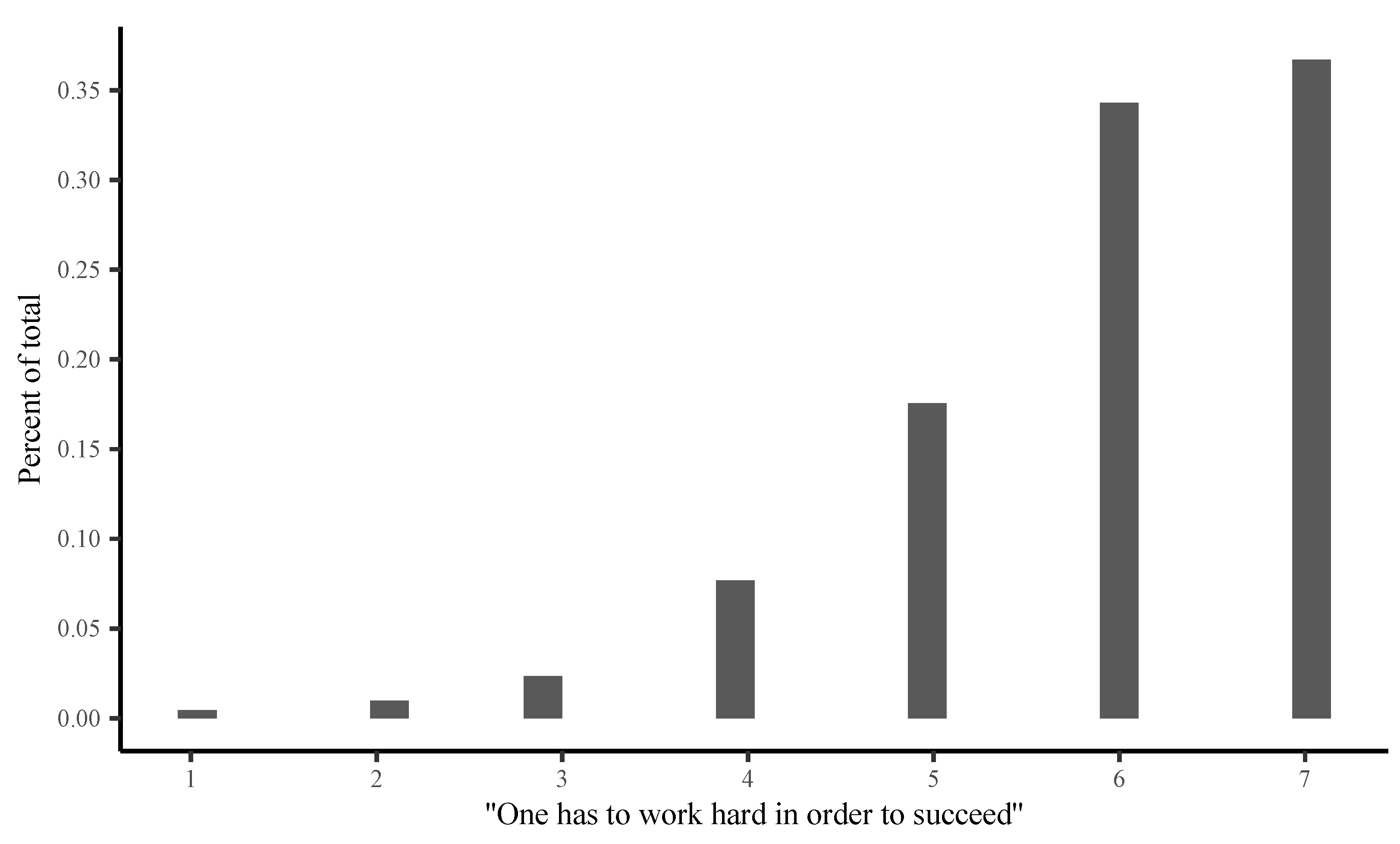
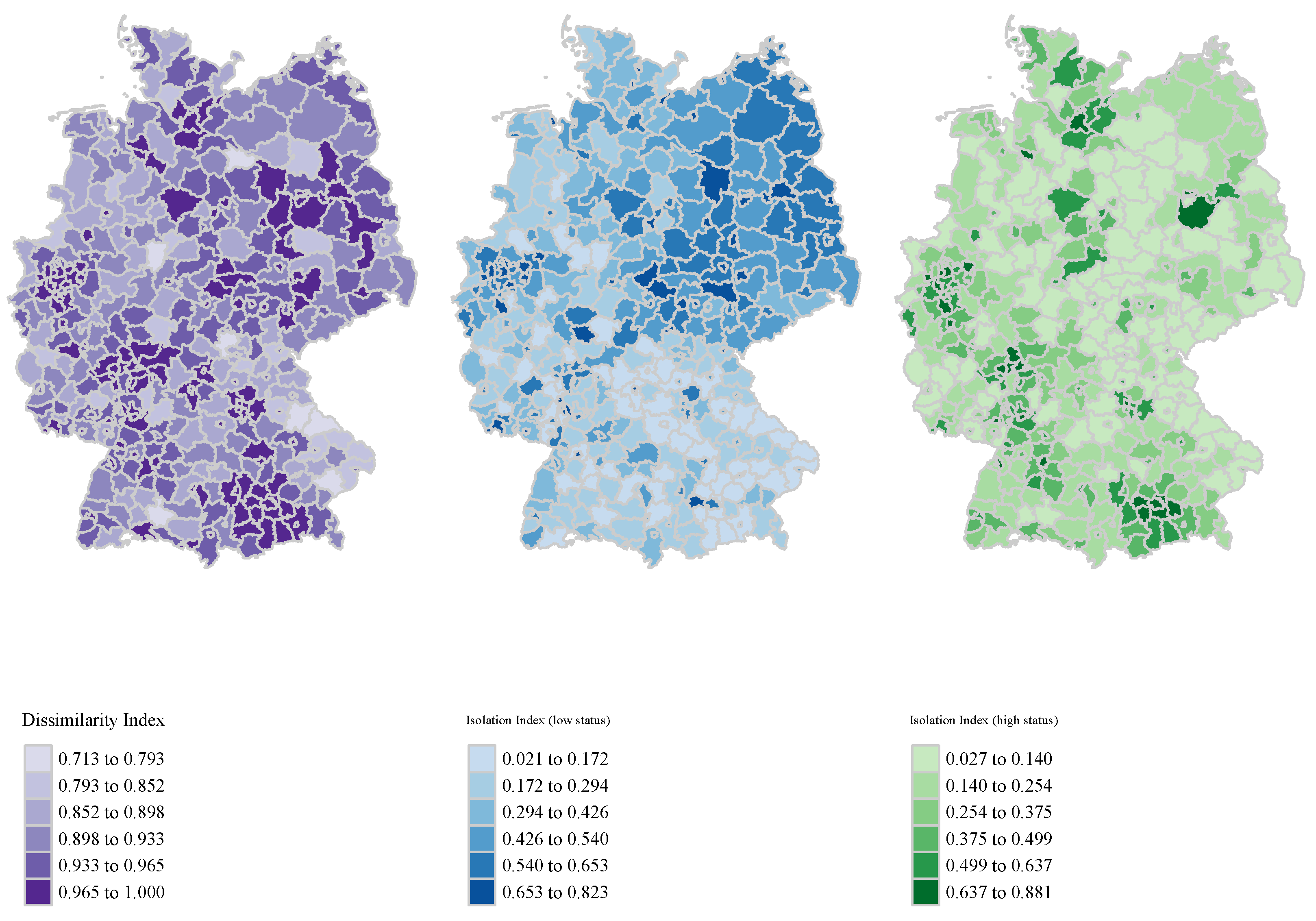
| Theory | Main Assumption | Mechanism | Anticipated Results |
|---|---|---|---|
| “Conflict Theory” (Newman et al. 2015) | Individuals hold latent class attitudes that influence their meritocratic beliefs. They are activated when inequality increases. | As inequality increases, it becomes more salient, heightening class consciousness, leading lower-/upper-class individuals to be critical/supportive of inequality. | When inequality is high, meritocratic beliefs decrease among the poor and increase among the affluent. |
| “Relative Power Theory” Solt et al. (2016) | Social discourses are influenced by power relations. When inequality increases, discourses change. | As inequality increases, so does the influence of those in power on public discourse, leading to an increase in meritocratic beliefs. | When inequality is high, meritocratic beliefs are high, especially among the poor. |
| “Contact Theory” Mijs (2018) | Higher inequality leads to more segregation between social groups, limiting contact. Interactions within a heterogeneous social group foster skepticism toward meritocratic principles. | Rising inequality leads to increased segregation which in turn limits intergroup contact and increases meritocratic beliefs. | When groups are segregated, meritocratic beliefs increase. |
| Authors | Country | Spatial Unit | Measure | Findings |
|---|---|---|---|---|
| Newman et al. (2015) | USA | Counties | Gini | Higher levels of inequality are associated with stronger meritocratic beliefs among the affluent and weaker meritocratic beliefs among the poor. |
| Solt et al. (2016) | USA | Counties | Gini | High levels of inequality are associated with stronger meritocratic beliefs, but only for low-income individuals. |
| Morris et al. (2022) | England | LSOAS | Gini 80:20 ratio | High levels of inequality are associated with stronger meritocratic beliefs, but only for low-income individuals |
| Variable | N | Mean | Std. Dev. | Min | Median | Max |
|---|---|---|---|---|---|---|
| Meritocratic Beliefs | 21,395 | 81.76 | 19.17 | 0.00 | 83.33 | 100.00 |
| District level | ||||||
| Dissimilarity index | 21,395 | 0.94 | 0.044 | 0.71 | 0.95 | 1.00 |
| Isolation index (poor) | 21,395 | 0.45 | 0.20 | 0.021 | 0.48 | 0.82 |
| Isolation index (rich) | 21,395 | 0.35 | 0.22 | 0.027 | 0.32 | 0.88 |
| Avg. disposable monthly income p.p. (000 €) | 21,395 | 1.73 | 0.21 | 1.27 | 1.72 | 2.99 |
| Population density | 21,395 | 898.46 | 1138.72 | 36.27 | 304.01 | 4668.11 |
| Foreign population | 21,395 | 10.10 | 5.67 | 1.90 | 9.02 | 33.60 |
| Proportion of SGBII recipients | 21,395 | 9.19 | 4.85 | 1.09 | 8.40 | 23.79 |
| Proportion of high-income households | 21,395 | 20.30 | 5.73 | 9.19 | 19.85 | 47.61 |
| Region | 21,395 | |||||
| West | 16,227 | 76% | ||||
| East | 5168 | 24% | ||||
| District type | 21,395 | |||||
| urban | 13,754 | 64% | ||||
| rural | 7641 | 36% | ||||
| Individual level | ||||||
| OECD equivalized household income (EUR 000) | 21,395 | 1.97 | 1.34 | 0.00094 | 1.71 | 69.41 |
| Moved in the past year | 21,395 | |||||
| did not move | 21,046 | 98% | ||||
| moved | 349 | 2% | ||||
| Duration of residence (years) | 21,395 | 13.06 | 12.74 | 1 | 6 | 100 |
| Gender | 21,395 | |||||
| female | 11,533 | 54% | ||||
| male | 9862 | 46% | ||||
| Migration background | 21,395 | |||||
| none | 16,771 | 78% | ||||
| first generation | 3431 | 16% | ||||
| second generation | 1193 | 6% | ||||
| Age group | 21,395 | |||||
| aged under 64 | 16,494 | 77% | ||||
| aged 65+ | 4901 | 23% | ||||
| University educated | 21,395 | |||||
| university degree | 5512 | 26% | ||||
| no university degree | 15,883 | 74% | ||||
| Unemployed | 21,395 | |||||
| not unemployed | 20,399 | 95% | ||||
| unemployed | 996 | 5% | ||||
| Religion | 21,395 | |||||
| not religious | 7198 | 34% | ||||
| religious | 14,197 | 66% | ||||
| Political attitude | 21,395 | |||||
| other | 9473 | 44% | ||||
| left-leaning | 7422 | 35% | ||||
| right-leaning | 4500 | 21% | ||||
| “One Has to Work Hard in Order to Succeed” | ||||||
|---|---|---|---|---|---|---|
| “Dissimilarity Index” | “Isolation Index (Low Status)” | “Isolation Index (High Status)” | ||||
| (I) | (II) | (III) | (IV) | (V) | (VI) | |
| District level | ||||||
| (Intercept) | 86.78 (4.84) *** | *** | *** | *** | *** | *** |
| Index | ** | *** | ||||
| Avg. monthly income (EUR 000) | ||||||
| Population density | ||||||
| Foreign population | ||||||
| Basic security benefits (>12.3%) | * | * | ** | * | ||
| High-income households (>24%) | ||||||
| Region: East | ** | ** | ** | * | ** | ** |
| Rural Areas | * | ** | * | * | ||
| Individual level | ||||||
| Household income (EUR 000) | ||||||
| Moved in the past year | ||||||
| Duration of residence (years) | ||||||
| Male | *** | *** | *** | *** | *** | *** |
| First generation migrant | *** | *** | *** | *** | *** | *** |
| Second generation migrant | *** | *** | *** | *** | *** | *** |
| Aged 65+ | *** | *** | *** | *** | *** | *** |
| No university degree | *** | *** | *** | *** | *** | *** |
| Unemployed | ||||||
| Religious | ||||||
| Left-leaning | *** | *** | *** | *** | *** | *** |
| Right-leaning | * | * | * | * | * | * |
| Interaction terms | ||||||
| Index × income | ||||||
| Index × rural area | ** | |||||
| Index × benefits | ||||||
| Index × high income | ||||||
| Num. obs. | 21,395 | 21,395 | 21,395 | 21,395 | 21,395 | 21,395 |
| Num. groups: hid:kkz_rek | 13,412 | 13,412 | 13,412 | 13,412 | 13,412 | 13,412 |
| Num. groups: kkz_rek | 400 | 400 | 400 | 400 | 400 | 400 |
| Var: hid:kkz_rek (Intercept) | ||||||
| Var: kkz_rek (Intercept) | ||||||
| Var: Residual | ||||||
| “One Has to Work Hard in Order to Succeed” | ||||
|---|---|---|---|---|
| ‘Rural’ | ‘Urban’ | |||
| (VII) | (VIII) | (IX) | (X) | |
| District level | ||||
| (Intercept) | 73.25 (6.73) *** | *** | *** | *** |
| Index | *** | ** | ||
| Avg. monthly income (EUR 000) | ||||
| Population density | ||||
| Foreign population | ||||
| Basic security benefits (>12.3 %) | * | |||
| High-income households (>24%) | * | |||
| Region: East | ||||
| Individual level | ||||
| Household income (EUR 000) | ||||
| Moved in the past year | ||||
| Duration of residence (years) | ||||
| Male | * | * | ** | ** |
| First-generation migrant | *** | *** | *** | *** |
| Second-generation migrant | ** | ** | *** | *** |
| Aged 65+ | ** | ** | *** | *** |
| No university degree | *** | *** | *** | *** |
| Unemployed | ||||
| Religious | ||||
| Left-leaning | * | * | *** | *** |
| Right-leaning | * | * | ||
| Interaction terms | ||||
| Index × income | ||||
| Index × benefits | ||||
| Index × high income | ||||
| Num. obs. | 7641 | 7641 | 13,754 | 13754 |
| Num. groups: hid:kkz_rek | 4724 | 4724 | 8688 | 8688 |
| Num. groups: kkz_rek | 202 | 202 | 198 | 198 |
| Var: hid:kkz_rek (Intercept) | ||||
| Var: kkz_rek (Intercept) | ||||
| Var: Residual | ||||
Disclaimer/Publisher’s Note: The statements, opinions and data contained in all publications are solely those of the individual author(s) and contributor(s) and not of MDPI and/or the editor(s). MDPI and/or the editor(s) disclaim responsibility for any injury to people or property resulting from any ideas, methods, instructions or products referred to in the content. |
© 2023 by the authors. Licensee MDPI, Basel, Switzerland. This article is an open access article distributed under the terms and conditions of the Creative Commons Attribution (CC BY) license (https://creativecommons.org/licenses/by/4.0/).
Share and Cite
Oetke, N.; Norkus, M.; Goebel, J. Assessing the Effects of District-Level Segregation on Meritocratic Beliefs in Germany. Soc. Sci. 2023, 12, 376. https://doi.org/10.3390/socsci12070376
Oetke N, Norkus M, Goebel J. Assessing the Effects of District-Level Segregation on Meritocratic Beliefs in Germany. Social Sciences. 2023; 12(7):376. https://doi.org/10.3390/socsci12070376
Chicago/Turabian StyleOetke, Nicole, Maria Norkus, and Jan Goebel. 2023. "Assessing the Effects of District-Level Segregation on Meritocratic Beliefs in Germany" Social Sciences 12, no. 7: 376. https://doi.org/10.3390/socsci12070376
APA StyleOetke, N., Norkus, M., & Goebel, J. (2023). Assessing the Effects of District-Level Segregation on Meritocratic Beliefs in Germany. Social Sciences, 12(7), 376. https://doi.org/10.3390/socsci12070376






